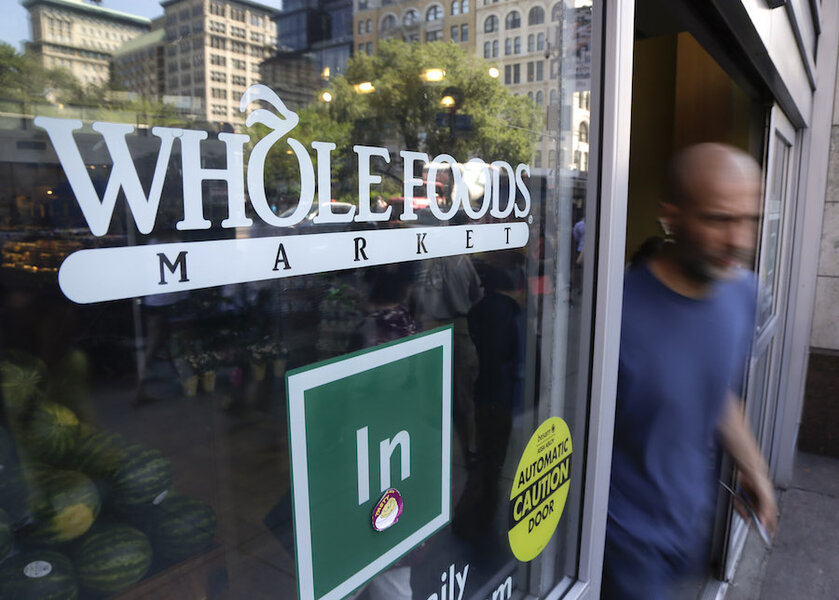Twelve ways to save money at Whole Foods
Loading...
Whole Foods has some of the best produce, organic finds, and gourmet treats. However, Whole Foods can also be very expensive, and you can easily spend way more than you bargained for. That's why we've come up with some of the easiest ways to save money at Whole Foods.
1. Shop on a Wednesday or Friday
While you can find special deals every day of the week (like $1 Taco Tuesday), you'll enjoy the greatest savings at Whole Foods on Wednesdays and Fridays. New weekly sales start on Wednesdays, and if you get there early in the day, you can get first dibs on the new items while still catching sales from the previous week. They also offer Friday-only sales.
2. Bring Your Own Reusable Bags and Jars
Sure, $0.10 per bag may not seem like a lot, but over time, forgetting to bring your reusable bags can really add up. Along with saving you money, bringing your own bags is also better for the environment. If you are planning on shopping the bulk bins, bring your own jars or containers, too. Customer service will weigh the jar before you go to the bulk section to subtract the weight from your total purchase.
3. Buy the 365 Brand
The 365 brand is Whole Foods' generic line of packaged items. They have all the basics you'll need, along with hundreds of organic products. Fortunately, the 365 brand items are actually really good. In fact, 365 has become so popular that plans are in motion to open smaller value stores called 365 by Whole Foods Market. They are set to open five locations in the second half of 2016.
4. Buy in Bulk
Whenever you are able to buy in bulk, you can save up to 10% on your purchase. Simply freeze any extra ingredients or items that won't be in season for long. If you are a wine drinker, purchasing six bottles of wine at a time will save you 10%. You can also look for the Three Wishes brand, which is Whole Foods' bargain store label (under $5 a bottle). Make sure to also visit the bulk bins, where you can save money on nuts, pasta, oats, dried fruit, herbs, spices, and even candy.
5. Don't Make Whole Foods Your Only Grocery Stop
Sure, organic, locally sourced food tastes better, but you shouldn't spend your whole food budget on it. For a quick rule of thumb, if you will be eating the skin, you should go organic. Otherwise, you'll likely find cheaper generic produce at your local farmer's market or grocery store. Shop at your regular grocery store for all of your staple items, too, and leave Whole Foods for specialty items like fancy cheese and prepared foods.
6. Make Returns When Necessary
If you've overspent or changed your mind about something, simply return it to the store. Whole Foods has a habit of hiding prices on certain specialty items, so don't be ashamed of making a return when you've accidentally spent too much.
7. Buy More Frozen Items
Frozen food is usually cheaper, and you won't have to sacrifice quality or selection. In fact, in many cases, frozen produce has the same or more benefits compared to fresh. Go for frozen fish and meat, too. You might think you are purchasing fresh fish at the seafood counter, but often it's actually been previously frozen — so you may as well buy frozen to begin with and save on cost. With Individually Quick Frozen (IQF) shrimp or chicken, thaw only what you need, and have cost-effective meals ready to go.
8. Stick to Your List
Take inventory of what you have at home before you head to Whole Foods. Make a list of what you need and stick to it. Items at the checkout line are meant to attract your attention and entice you to buy them, so try to ignore them. Getting free samples throughout the store is great, but only if you are able to bypass the temptation to buy.
9. Look for Deals
Clipping or downloading coupons is also a great way to save at Whole Foods. You could also be more direct, and keep an eye out for yellow and red discount tags in the store or check Whole Foods' website, weekly circular, and social media pages to find up-to-date sales. While you're shopping, ask the butcher, deli, bakery, or any store associate about which special one-day sales are available. (See also: Save $100s Next Month With These 10 Grocery Shopping Tips)
10. Take Advantage of Budget-Friendly Recipes
Whole Foods offers helpful tips and solutions for their budget-minded shoppers. For instance, you can take advantage of their budget-friendly recipes and servings calculator to figure out how much food you need for big events and dinner parties.
11. Get a Supplement Punch Card
With a supplement punch card, you can enjoy savings and cash back after spending a certain amount of money on 365 Everyday Value brand supplements. The 365 Everyday Value supplements are more affordable, but can provide the same ingredients and results as big name brands.
12. Use Caution at the Salad Bar
Whole Foods has an impressive salad bar. However, the price is determined by weight, so it can be easy to get carried away with heavier items.
On the other hand, if you need a small amount of a particular side dish, you'll save money by buying a small amount of that dish at the salad bar. For instance, buying a small container of prepared potato salad can be cheaper than buying all the ingredients required to make several servings of potato salad that you can't finish.
This article first appeared at Wise Bread.







